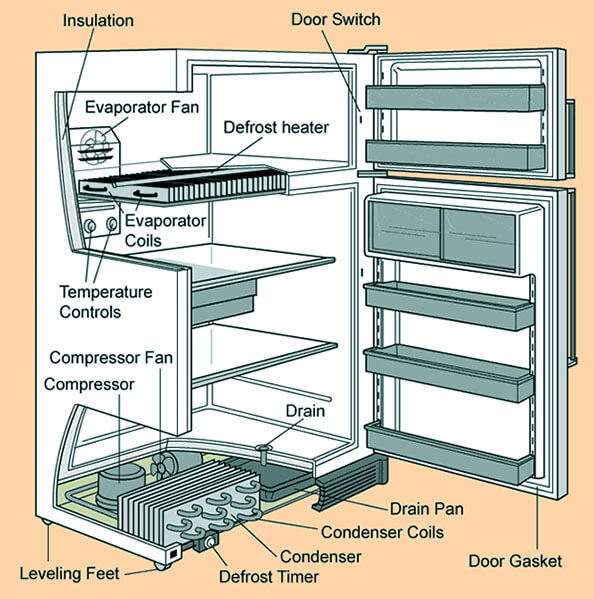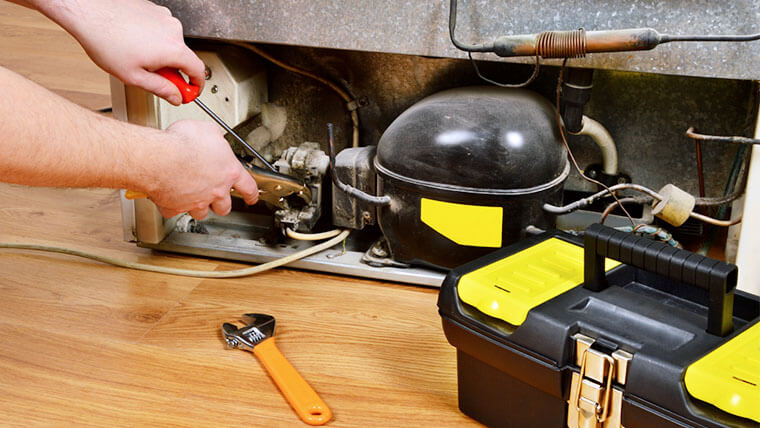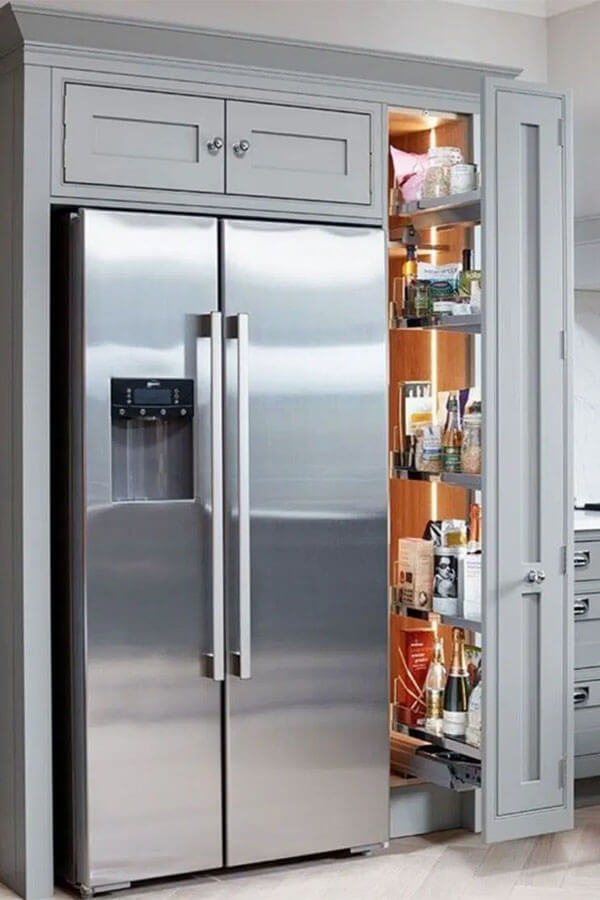A fridge might not be the noisiest appliance in your kitchen, but it constantly runs for 24 hours. Therefore, its irritating sound can exceed your tolerance level. That’s why many people are looking for solutions to quiet a noisy refrigerator.
To reduce refrigerator noise, you need to figure out where the noise comes from inside the appliance first. The compressor is a major component containing the motor and pump, so we will pay more attention to this part.
And our work does not limit to making a fridge compressor quieter, as other compartments such as the freezer can also make noises.
Why Is My Refrigerator Making a Loud Noise?
Before discussing how to fix a noisy refrigerator compressor in the next section, we should learn common causes that make your machine work louder than you expect.

1. The Compressor
A compressor includes a motor and pump system, letting liquids like water and oil flow through the refrigerator, and of course, it produces airborne noise.
Some common factors making a noisy refrigerator compressor are as the following:
Liquid Flow
The oil flow in the compressor can cause dripping noise.
A buzzing sound may occur when the water inlet valve is opened to allow for water dispensation. Besides, you may hear water dribble while running inside the compressor.
The refrigerant flow can make that dribbling sound, too. The floor refrigerant is also the cause of some hissing sound.
The Fans
The compressor fans of your refrigerator must be readjusted regularly for optimal efficiency. As a result, you may hear a pulsating or whirring noise from your machine.
Moreover, the fans need to work harder when you keep the door open or forget to close it. Leaving them running for a long time can also lead to a noisy compressor.
2. Other Sources of Refrigerator Noise
The Fridge’s Position
If you place your fridge unevenly on the floor, at least 1 out of 4 levelers will touch the floor while the machine is working and create a vibration noise.
The Freezer
You may hear a gurgling noise during the defrost cycle due to the melting ice and a sizzling noise as water drips down the heater. What’s more, the ice cubes falling into the ice tray, creating a funny clattering sound.
The Drip Tray
When the internal drip tray fills up, it makes gurgles, sizzles, and hisses. These are such normal noises of the draining water in your fridge.
The Internal Walls
The refrigerator walls contract and expand to heat and cool according to temperature changes in your fridge. You can expect a variety of popping, creaking, and clicking sounds due to this function.
Is It Normal for a Brand New Fridge to Make Noise?
Noises coming from the ice maker or the drip tray are just normal sounds. You can hear them in many modern self-defrost models.
Even a brand new fridge with a quiet tag on it will probably deliver some sound once in a while. Don’t worry, such airborne noise is normal as it is part of the regular operation of the fridge.
In addition, it’s not uncommon for the door of a new refrigerator to whistle or squeak. This is because the gasket is wrapping tightly around the inner circumference of the door. This noise will subside after a few days as the gasket gets loose.

How to Quiet a Noisy Refrigerator
There’re many effective solutions to make a refrigerator quieter, and the most common ways are mentioned below.
1. Check The Machine’s Placement
Sometimes the cause of the airborne noise isn’t something that big; it’s just bad placement. Try repositioning your refrigerator; keep it far away from your living room or bedroom.
Furthermore, make sure all 4 legs of the machinery are level. If the refrigerator is not level, it will vibrate stronger and increase the airborne noise significantly. Ensure that your fridge remains flat and that it suits well to minimize rotation when placed in a compartment.
Detecting this issue is quite easy with a little rattle on your refrigerator. If it moves, you have to level out the legs accordingly. Almost all fridges have flexible leveling legs for an independent setting. This feature is a huge aid for rough surfaces. If necessary, you can purchase an adjustable stand for easy installation.

2. Separate Your Fridge and The Floor
The second easiest method to make your machine quieter is to put it on an anti-vibration foam or a rubber mat. This will create some distance between your fridge and the floor and cut the vibrational noises by 50 to 60%.
Buy a thick, specific pad/mat if your house’s floor surface is slippy; otherwise, you can use a normal sound dampening rug. Vehicle sound deadening rugs are also good options.
These products are mainly made of a dense substance with minimum elasticity called butyl rubber. It is perfect for absorbing vibrations and sound waves from your noisy fridge compressor.
3. Soundproofing Behind Your Refrigerator
If the noise is still a problem, then try soundproofing your refrigerator. The problem doesn’t come from the floor only. It may be the result of the distance between your fridge rear and the wall.
While the compressor coils are running, they let fluid flow through the fridge’s back to release extra heat. The sound waves from the fridge bounce off the wall, causing airborne noise.
However, you can just cover it up since it makes the compressor overheat and conk out. Combining noise blocking and an acoustic solution is the best tactic.
Make a DIY soundproofing board with an acoustic foam product for this solution. This arrangement makes sure the refrigerator’s back touches the access panel. The acoustic panel right behind will trap and damp 50-90% sound from the refrigerator.
- Move your refrigerator out of its position.
- Cut or find a wood or MDF sheet that matches the size of your refrigerator rear wall, plus some extra inches on each edge.
- Attach a mass-loaded vinyl piece onto it with glue or nails. It is a limp mass, so it doesn’t transmit vibration, it blocks noise that might occur.
- Cover the wood with acoustic foam tiles for better sound trapping.
- Insert it on the wall behind your refrigerator and place the machine back.
4. Soundproofing Inside Your Refrigerator
External soundproofing may not be enough. That’s when you should add internal soundproofing material to your fridge. We recommend using mass-loaded vinyl as it offers excellent airborne noise reduction.
This material is thin, not too heavy, and easy to mold on any surface. Moreover, it can absorb noises passing through and prevent them from leaking.
- Turn off your fridge and defrost for a while
- Remove all food, beverage, and obstructions, even the shelves
- Clean the inside of the fridge, let it dry
- Measure your fridge’s internal area’s top, sides, back, and bottom. Cut 5 pieces of mass-loaded vinyl to fix in here. It is advisable to consider the size carefully since a quarter-inch thick material takes up about one inch of space
- Attach the 5 pieces to the fridge’s walls using glue. Make sure to leave holes and grooves for the interior parts such as shelves, drip tray, ice tray, etc.
- Put everything back into place and turn the fridge back on
- Like any other soundproofing material, mass-loaded vinyl may affect the fridge’s temperature. It would be best if you used a thermometer to monitor. Keep an eye on it and adjust accordingly.
5. Clean The Compressor Fan and Condenser
Another way to deal with a noisy refrigerator compressor is to keep it in great condition. Dirt and dust can build up around the compressor fans, causing malfunction.
Get your refrigerator noise reduction kit ready and follow this step-by-step instruction to make its fan clean and silent again:
- Turn off and unplug your fridge from the power outlet
- Use a screwdriver to remove the access panel located on the back of your refrigerator
- Look for any dirt, sand, gravel, or debris in this area. It can cause some noises and is easy to wipe out.
- Check the amount of dirt on the fan blades. Run a hand vacuum all over them and the condenser area to gently take off all the dirt (recommended). In case you don’t have one, use a normal vacuum instead.
- If there’s any damage to the blades, replace them with new ones. You can easily find them online or at any cabinet outlet.
- If the fans and the surrounding area all appear to be fine, give them a light clean with a soft cleaning cloth (microfiber recommended). This step helps collect any last pieces of rubble left.
- Screw the access panel in the machine and turn your refrigerator back on
But remember to check your owner’s manual before opening the back of your refrigerator since they might offer a cleaning maintenance service. Besides, taking an under-warranty refrigerator apart could void its warranty terms.
Maintenance is important for all machines. Clean it regularly if you want your appliance to run quieter, not only the compressor but also the whole fridge. Use a dry cloth to wipe the interior and exterior of your refrigerator.
6. Construct a Cabinet for Your Refrigerator
This method requires a large space and some craft skills. It’s building an alcove to store your fridge, soundproof, and refresh the look of your kitchen corner.
The “house” will cover the fridge, and it is said that adding more mass to the surrounding area can help to absorb more noises. In addition to this, you can fill the unit with dense and heavy kitchen stuff, or add more acoustic foam panels to increase the construction’s mass.

However, you need some knowledge to build it properly. Don’t cover all the sides of your fridge with no free space, especially the backside. It’s critical for ventilation since the machine needs room for airflow and releasing heat.
When adding stuff to the cupboards, avoid objects like plates, cups, pots, or pans because you will hear a rattling noise if the fridge vibrates powerfully, causing more noises.
Furthermore, this unit can protect the machinery from your mischievous children and pets’ scratches. It also works as a decorative area. You can easily hang curtains on the wooden housing.
7. Don’t Run The Fridge at a Very Low Temperature
It sounds a bit paradoxical, but refrigerators running at extremely low temperatures for a long time may face malfunctions, and of course, noise.
Commercial fridges are not made for very low temperatures – the annoying sound will occur when the machine shrinks and expands inside the wall according to the temperature changes.
Besides, the cooling chamber produces sizzles at such temperatures. The temperature difference is so large that it will turn a drop of water into vapor immediately because the outside temperature is too high for it.
Therefore, you should set a proper temperature as usual. You can decrease it if needed, but not too low, and then increase it back to normal.
Final Words
So there you knew how to quiet a noisy refrigerator. We hope the solutions will work well on your loud refrigerator.
Some of them are permanent and some are temporary. Using only 1 tip will probably not be enough or make any big change. Combine as many methods as possible for the best effect.
However, these tips might not work for severe cases. If you don’t see any major changes in the sound quality after applying all of the mentioned ones, we recommend replacing the compressor as it is the biggest noise source in your fridge. If that still does not help, you should buy a new refrigerator that runs more quietly.
You might also want to read:
- How to Reduce Noise From Upstairs Floors
- Simple Ways to Make Your Room Fan Quieter
- Soundproofing French Glass Doors with 6 Proven Ways

